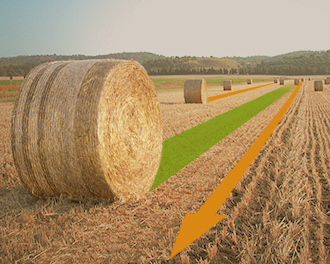FARM GROWN SOLUTIONS
Film usage for round bales
The number of bales that can be wrapped from a single roll of stretchfilm can be easily calculated, providing all of the following points are understood and adhered to.
6 film layers – 36 turns for 500mm film and 24 turns for 750mm
To calculate the correct figure, the three following factors must be maintained.
By using the following calculation, the total number of bales/ roll can thus be calculated
| Example 1. | Bales with 4 layers film application | |||
| Film size | A Bale circumference |
B Turns of the bale |
C Total film length |
Bales/roll |
| 500mm x 1,800m | 4.8m (1.2m diameter x 4) |
24 | 3,060m (1,800m x 70%) |
26 |
| 750mm x 1,500m | 4.8m (1.2m diameter x 4) |
16 | 2,550m (1,500m x 70%) |
33 |
| Example 2. | Bales with 6 layers film application | |||
| Film size | A Bale circumference |
B Turns of the bale |
C Total film length |
Bales/roll |
| 500mm x 1,800m | 4.8m (1.2m diameter x 4) |
36 | 3,060m (1,800m x 70%) |
17 |
| 750mm x 1,500m | 4.8m (1.2m diameter x 4) |
24 | 2,550m (1,500m x 70%) |
22 |
Any variation in any of the following will alter the number of bales per roll.
• Bale size
When bale size changes, the calculation to determine correct and full bale coverage is
- Count the turns to completely cover the bale
- Add one more turn
- Repeat again for 4 layers (or twice more for 6 layers)
• Number of turns to the bale
Insufficient turns of the bale will result in a reduction in film layers on the bale, leading to the possibility of film splits after wrapping.
• Film % stretch
Most machines are correctly calibrated to 70% stretch, this can vary depending upon condition of pre-stretch rollers and roller gearing.





